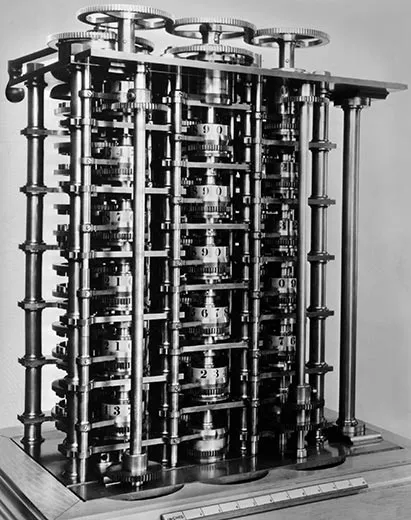Booting Up a Computer Pioneer’s 200-Year-Old Design
Charles Babbage, the grandfather of the computer, envisioned a calculating machine that was never built, until now
/https://tf-cmsv2-smithsonianmag-media.s3.amazonaws.com/filer/Charles-Babbage-631.jpg)
When today’s number crunchers want to make quick calculations, they reach for their smartphone, a device practically unimaginable two centuries ago. But in the 1820s, at least one forward-thinking mathematician envisioned a calculating machine, albeit far from portable. Frustrated by the human errors he found in printed numerical tables, English inventor Charles Babbage designed a machine to perform mathematical functions and automatically print the results. His initial design, which called for 25,000 parts, would have weighed 15 tons and been about the size of a horse-drawn carriage.
The plans looked good on paper, but Babbage was never able to build his machine. More than a century after his death in 1871, computer historians blew the dust off his 5,000 pages of notes and drawings and wondered if his ideas could work. In 1991, on the bicentennial of Babbage’s birth, the Science Museum in London unveiled his Difference Engine No. 2, a fully functioning calculating machine, built to the specs of the inventor’s drawings. A full-scale clone of that machine is now on display in Mountain View, California, at the Computer History Museum through December 2009.
Babbage called his invention a “difference engine” because its function is based on the mathematical principle of finite differences, which calculates complex mathematical functions by repeated addition without the use of multiplication or division. Constructed in a cast-iron frame, the machine on display is 11 feet long and 7 feet tall. With each turn of its crank, steel and bronze cams and rods spring into precise action, clicking softly like a Victorian clock. Spinning steel brackets and columns of gearwheels, which represent numbers, create a fluid mechanized helical dance. There are no touch screens, of course, but after four cranks, the machine can calculate an algebraic equation in six seconds.
Babbage was born in 1791 at the onset of England’s Industrial Revolution. He studied at Cambridge, and thanks to an inheritance from his wealthy father, had leisure time to think about how things worked and improve on them. Babbage invented the cowcatcher, a device on the front of a train that clears debris without slowing the train. He also improved lighthouse signaling and created a quick-release system for railway carriages. Living amid all the wondrous changes wrought by the industrial age, Babbage, surveying yet another error-ridden set of printed numerical tables, once exclaimed: “I wish to God these calculations had been executed by steam!”
Up until 40 years ago, engineers, navigators, astronomers and bankers used slide rules and books of tables to perform calculations. “The defining event which brought the end of the slide rule and the books of tables was in 1972, when Hewlett-Packard introduced the HP-35,” says the computer museum’s senior docent, Tim Robinson. “This was the first hand-held, full-function scientific calculator that replaced all the normal functions of tables and the slide rule.”

Though the exact creator of the very first calculator is debatable, Babbage is counted among the pioneers who designed a machine that could reliably compute equations. In an attempt to build his difference engine in the 1830s, Babbage secured funding from the British government and commissioned engineer and toolmaker Joseph Clement to make the 25,000 parts. When Clements had finished about half the parts, he and Babbage had an irreconcilable dispute and the project was halted.
After a decade of work, all Babbage had to show for his efforts was a small demonstration machine, used to impress parlor guests at his Saturday soirees. Both Charles Dickens and Charles Darwin turned the handle of the machine that was considered an engineering breakthrough for its time. Often referred to as the “beautiful fragment,” it is one of the most prized artifacts in the London Science Museum.
Once he lost his financial backers for the calculating machine, Babbage designed and partially built an ambitious device he would call the “Analytical Engine.” Tinkering with it for many years, he applied many of the same principles and features found in today’s computers, including programmable punch cards and iteration. It is mainly because of his Analytical Engine that Babbage is considered the “grandfather of the computer.”
“He was a thoroughly modern thinker in how he thought about computing,” said former Microsoft technology officer Nathan Myhrvold in a lecture at the Computer History Museum.
Using what he had learned developing the Analytical Engine, Babbage modified the design of his difference calculating machine but died before he could build it. Toward the end of the 20th century, several computer geeks pored over his designs. Doron Swade, then the curator of computing at the Science Museum in London, decided to build the Difference Engine No. 2 without knowing for sure if it would work. It took him 17 years, but when he finished, it worked just as Babbage said it would.
The difference engine was nearly ready for Babbage’s birthday celebration, but the project ran out of money before completion of the machine’s typeset and print functions. When Microsoft’s Bill Gates saw the work in progress, he suggested that Myhrvold, who's an inventor, archaeologist and investor, might finance the completion of it. Only if the London Museum agreed to build a working replica for his private collection, Myhrvold said in sealing the deal. After the colossal calculator leaves the Silicon Valley museum, it’s bound for Myhrvold’s home in Seattle, perhaps joining the Tyrannosaurus rex skeleton in his living room.
Meanwhile, the machine is demonstrated Wednesday through Friday at 2 p.m. and on weekends at 1 and 2 p.m. During a recent visit, a docent turned the crank of the foot-wide wheel, putting her back into it. As the gears and cams clicked into motion, one onlooker remarked that the movement looked like the double helix of DNA. The audience seemed mesmerized by the calculator’s elegant precision. At long last, Babbage’s genius was getting its due.